5cfb7de8c1dee6f19306463861cad945.ppt
- Количество слайдов: 65

Systems Analysis & Design Methods Budhi Buscas Edward Savage Bradley Stockton Ridwan Syafei Systems Analysis and Design 1

“The computer is a moron. ” Peter Ferdinand Drucker (November 19, 1909–November 11, 2005) see an example here… “People think computers will keep them from making mistakes. They're wrong. With computers you make mistakes faster. ” Adam Osborne (March 6, 1939 – March 18, 2003) Systems Analysis and Design 2

Introduction Overview Present a hypothetical project Review applicable principles of IT Project management from class discussions Discuss general principles of systems analysis and design Review “waterfall” and “iterative” approaches to project development Apply these approaches to the hypothetical project Systems Analysis and Design 3

Hypothetical IT Project Online Advisory Module Create an online, personalized advising system System Functions Track progress and classes Create hypothetical personalized schedules based on historical semester offerings Analyze student progress to anticipate future class needs based on majors Provide customized information on alternative pathways Track feedback on quality of instruction and content. Goals Improve student graduation rate Optimize class size Minimize schedule conflicts Reduce size of advisory staff Reduce cost Systems Analysis and Design 4

Hypothetical IT Project As a manager: How should you proceed and what are the factors that impact on the development of this project? Systems Analysis and Design 5

Introduction Prior Discussion in Class Determinants of Success/Failure of IT Projects Cost of IT Projects Principles of Outsourcing for IT Projects Systems Analysis and Design 6

Introduction Determinants of Success/Failure of IT Projects Systems Analysis and Design Lecture, Lacity, MC: Management of IT-Enabled Business Projects, presented 2/28/07 7

Introduction Cost of IT Projects “Denver Airport -- Baggage Handling System” Keil, M. , and Montealegre, R. , "Cutting Your Losses: Extricating Your Organization When A Big Project Goes Awry, " Sloan Management Review, Vol. 41, 3, 2000, pp. 55 -68. “Expectations: $175. 6 million contract with BAE Automated Systems to develop the system 18 month schedule to complete, April 22 1992 to Oct 1993” “Outcome: Cancelled after horrible test in April 1994, after spending over $2 billion” As a manager approaching development projects - Where did this fail? Planning phase? Design phase? Implementation phase? What development methodology was used? Systems Analysis and Design 8

Introduction Lecture, Lacity, MC: Management of IT-Enabled Business Projects, presented 2/28/07 Determinants of Success/Failure of IS Projects As a manager, what development methodology should you choose? Systems Analysis and Design 9

Introduction Lecture, Lacity, MC: Nature of Information Technology Within Organizations, presented 1/31/07 Management Principles for IS Projects Governance and Decision Domains Systems Analysis and Design 10

Introduction How are Information Systems developed General Principles Development techniques Advantages and disadvantages for different methodologies. Systems Analysis and Design 11

Introduction Dennis A, Wixom BH, Roth RM. “Systems Analysis and Design” 3 rd ed. Wiley, 2005, pp 12 -13. General Methodology on Information systems development. “Waterfall Techniques” -- Each step of the process must be completed in sequence Structured Systems Analysis and Design Methods (SSADM) “Iterative” or “incremental” – develop systems in smaller steps with repeated iterations utilizing the information and knowledge gained from the first iteration Rapid Application Development Methods (RAD) Example: Hypothetical development project Systems Analysis and Design 12

Information Systems Development Lyytinen, K, Robey, D, “Learning failure in information systems development”, Information Systems Journal , Vol. 9. 2, 1999, p 85 -101. Information Systems Development (ISD): Definition: Creating “…value-adding processes that serve the needs of an organization. ” “Not just computers and computer code” (Brad Stockton –personal communication) Systems Analysis and Design 13

Information Systems Development http: //www. comp. glam. ac. uk/pages/s taff/tdhutchings/chapter 4. html Issues in early system development Unstructured Methodologies limited user involvement inadequate description of requirements unstructured analysis and design absence of easy to use tools inflexible storage and data management Systems did not satisfy business requirements lack of ownership requirements may have changed or been misunderstood inadequate analysis and design prior to delivery Systems Analysis and Design 14

Information Systems Development http: //www. comp. glam. ac. uk/pages/s taff/tdhutchings/chapter 4. html This lead to the development of “Structured methodologies” for system development Representative System Development Methodologies Clarify and reduce misunderstanding of business requirements by formalizing the descriptive process Standardize best practice techniques for the analysis and design process Systems Analysis and Design Structured Systems Analysis and Design Method (SSADM) Rapid Application Development (RAD) Architected Rapid Application Development (Architected RAD) Dynamic Systems Development Methodology (DSDM) Joint Application Development (JAD) Information Engineering (IE) Rational Unified Process (RUP) Structured Analysis and Design 15 e. Xtreme Programming (XP)

Information Systems Development Whitten, Jeffrey L. , Bentley, Lonnie D, and Dittman, Kevin , Systems Analysis and Design Methods, 7/e, Mc Graw-Hill, 2007 Stages: Development Operation and maintenance Systems Analysis and Design 16

Information Systems Development “Methodology: A codified set of recommended practices, sometimes accompanied by training materials, formal educational programs, worksheets and diagramming tools. Thick methodology: A methodology that includes a large amount of formal process paperwork and documentation Thin methodology: A methodology that eschews formal process paperwork and documentation. ” Systems Analysis and Design Software Project Management: Methodologies & Techniques SE Project 2003/2004 group E 17 th September 2004 http: //paul. luon. net/essays/SEP-essayfinal. pdf. Wikipedia | Methodology (Software engineering) http: //en. wikipedia. org/wiki/Methodology (software_engineering). Imperial College London | The Free On. Line Dictionary of Computing http: //foldoc. ic. ac. uk/foldoc/. 17

Information Systems Development Whitten, Jeffrey L. , Bentley, Lonnie D, and Dittman, Kevin , Systems Analysis and Design Methods, 7/e, Mc Graw-Hill, 2007 Information Systems Development methodology: A standardized sequence of Information Systems development processes which solve problems, give benefits, and competitive advantages to an organization. Systems Analysis and Design 18

Information Systems Development Sircar S, Nerur SP, Mahapatra R. “Revolution or Evolution? A Comparison of Object-Oriented and Structured Systems Development Methods” MIS Quarterly, 25, 4, 2001, pp. 457 -471. Systems Analysis and Design Analysis: Collect, compile and document the IS requirements, create models of the system. Design: Create specifications, design, implement and test Systems Analysis and Design 19

Information Systems Development Four Phases of Development Dennis, Alan, Wixom, Barbara, Roth, Roberta. Systems Analysis and Design 3 rd ed. , Wiley, Hoboken, 2005. Systems Analysis and Design 20

Information Systems Development Dennis, Alan, Wixom, Barbara, Roth, Roberta. Systems Analysis and Design 3 rd ed. , Wiley, Hoboken, 2005. Systems Analysis and Design 21

Information Systems Development Whitten, Jeffrey L. , Bentley, Lonnie D, and Dittman, Kevin , Systems Analysis and Design Methods, 7/e, Mc Graw-Hill, 2007 Principles: “Justify systems as capital investments. ” “Get the system users involved. ” “Don’t be afraid to cancel or revise scope. ” “Use a problem-solving approach. ” “Establish phases and activities. ” “Document throughout development. ” “Establish standards. ” “Manage the process and projects. ” “Divide and conquer. ” “Design systems for growth and change. ” Systems Analysis and Design 22

Hypothetical IT Project Online Advisory Module Create an online, personalized advising system System Functions Track progress and classes Create hypothetical personalized schedules based on historical semester offerings Analyze student progress to anticipate future class needs based on majors Provide customized information on alternative pathways Track feedback on quality of instruction and content. Goals Improve student graduation rate Optimize class size Minimize conflict Reduce size of advisory staff Reduce cost Systems Analysis and Design 23

Structured System Analysis and Design Dennis, Alan, Wixom, Barbara, Roth, Roberta. Systems Analysis and Design 3 rd ed. , Wiley, Hoboken, 2005. Overview “Waterfall Techniques” -Each step of the process must be completed in sequence The next phase cannot begin before the previous phase is completed. Structured System Analysis and Design Methods (SSADM) Systems Analysis and Design 24

Structured System Analysis & Design Methods (SSADM) Goodland M, Riha K: SSADM – an Introduction. http: //www. dcs. bbk. ac. uk/~steve/1/, viewed 3/10/2007. History n Developed by the Central Computer and Telecommunications Agency (UK) n Office of Government Commerce (OGC) n n en. wikipedia. org/wiki/Office_of_Gover nment_Commerce, viewed 3/10/2007. support the procurement and acquisition process of public sector organizations in the UK through policy and process guidance and the negotiation of overarching service and provision frameworks Made mandatory for new system development in 1983 Systems Analysis and Design 25

Structured System Analysis & Design Methods (SSADM) Goodland M, Riha K: SSADM – an Introduction. http: //www. dcs. bbk. ac. uk/~steve/1/, viewed 3/10/2007. • Define the system • Set the scope • Develop project plan Strategic Planning Feasibility Study Requirements Analysis Requirements Specification Full Study Logical System Specification Physical Design Construct and Test en. wikipedia. org/wiki/Structured_Syst ems_Analysis_and_Design_Method, viewed 3/11/2007 S S A D M Develop ment Production Systems Analysis and Design 26

Structured System Analysis & Design Methods (SSADM) Planning Goal: Reduce costs and improve student graduation rates by developing an online academic advisor application for My. Gateway • $250 k/year cost savings from reduced staff of Academic Advisors • $800 k increased revenue from student retention due to increased visibility and management of personal academic requirements Scope: Student activities related to managing their academic progress Budget: • $800 k/year 1 for development (10 FTE’s for 6 months) • $160 k/year for maintenance (2 FTE’s for 2 months) Systems Analysis and Design 27

Structured System Analysis & Design Methods (SSADM) Tasks: Gather specific business requirements Create system design Build system Write test conditions Execute test Implement system Train students Maintain system Systems Analysis and Design 28

Structured System Analysis & Design Methods (SSADM) Goodland M, Riha K: SSADM – an Introduction. http: //www. dcs. bbk. ac. uk/~steve/1/, viewed 3/10/2007. en. wikipedia. org/wiki/Structured_Syst ems_Analysis_and_Design_Method, viewed 3/11/2007 Strategic Planning Feasibility Study Requirements Analysis Requirements Specification Full Study Logical System Specification Physical Design Construct and Test S S A D M Analyze business and user requirements Develop ment Production Systems Analysis and Design 29

Structured System Analysis & Design Methods (SSADM) Business Requirements: Single access point to manage individual degree program Personal degree requirements Progress towards earning degree Remaining requirements Class suggestions based on individual needs and class availability Class add/drop functionality Comprehensive grade report and analysis Prospective schedule planning Class assignment Warning prompts Out of scope: Student tuition/fee information Tuition assistance functionality Email functionality Help center functionality Systems Analysis and Design 30

Structured System Analysis & Design Methods (SSADM) Cost / Service Tradeoff? Tuition fee/tuition functionality - $30 k/year Tuition assistance functionality - $1000 k/year Email functionality - $15 k/year Help Center functionality - $200/year Systems Analysis and Design 31

Structured System Analysis & Design Methods (SSADM) Software Project Management: Methodologies & Techniques SE Project 2003/2004 group E 17 th September 2004 http: //paul. luon. net/essays/SEP-essay -final. pdf, viewed 3/29/2007. Data Flow Modeling (DFM): Identify, model and document data flow in the business information system http: //www. comp. glam. ac. uk/pages/s taff/tdhutchings/chapter 4/sld 008. htm, viewed 3/29/2007. Data transformation processes Data storage External entities (things which send data into a system or receive data) Data flow paths Students Faculty Database Administration Systems Analysis and Design 32

Structured System Analysis & Design Methods (SSADM) Logical Data Modeling (LDM): n Identify, model and document data requirements Entity (Required business information) n Relationships between entities. n Course Descriptions Software Project Management: Methodologies & Techniques SE Project 2003/2004 group E 17 th September 2004 http: //paul. luon. net/essays/SEP-essayfinal. pdf. http: //www. comp. glam. ac. uk/pages/sta ff/tdhutchings/chapter 4. html, viewed 3/29/2007. http: //www. comp. glam. ac. uk/pages/sta ff/tdhutchings/chapter 4/sld 007. htm, viewed 3/29/2007 Course Schedules Courses Taken Grades Database Academic Plan Systems Analysis and Design 33

Structured System Analysis & Design Methods (SSADM) Entity/Event Modeling (EM): n Identify, model and document the sequence of business events n Software Project Management: Methodologies & Techniques SE Project 2003/2004 group E 17 th September 2004 http: //paul. luon. net/essays/SEP-essay -final. pdf, viewed 3/29/2007. http: //www. comp. glam. ac. uk/pages/s taff/tdhutchings/chapter 4/sld 007. htm, viewed 3/29/2007. Entity Life History (ELH) Student Course Requirements and Desired Electives Prerequisites Database Courses taken Course Schedules Student Academic Plan Systems Analysis and Design 34

Structured System Analysis & Design Methods (SSADM) Goodland M, Riha K: SSADM – an Introduction. http: //www. dcs. bbk. ac. uk/~steve/1/, viewed 3/10/2007. Models: Data Flow Logical Data Entity/Event Strategic Planning Feasibility Study Requirements Analysis Requirements Specification Full Study Logical System Specification Physical Design Construct and Test Develop ment S S A D M en. wikipedia. org/wiki/Structured_Syst ems_Analysis_and_Design_Method, viewed 3/11/2007 Functions Requirements Specification Production Outputs Systems Analysis and Design Data Formats Inputs 35

Structured System Analysis & Design Methods (SSADM) Goodland M, Riha K: SSADM – an Introduction. http: //www. dcs. bbk. ac. uk/~steve/1/, viewed 3/10/2007. en. wikipedia. org/wiki/Structured_Syst ems_Analysis_and_Design_Method, viewed 3/11/2007 Strategic Planning Feasibility Study Requirements Analysis Requirements Specification Full Study Logical System Specification Physical Design Construct and Test Production Develop ment S S A D M Inputs: Class Prerequisites Graduation Requirements Past and Projected Schedules Functions: Create logical class sequences Analysis of student progress Data Formats Outputs: Suggested pathways Warnings about unstable paths Schedule plans Systems Analysis and Design 36

Structured System Analysis & Design Methods (SSADM) Goodland M, Riha K: SSADM – an Introduction. http: //www. dcs. bbk. ac. uk/~steve/1/, viewed 3/10/2007. en. wikipedia. org/wiki/Structured_Syst ems_Analysis_and_Design_Method, viewed 3/11/2007 Strategic Planning Functions Requirements Specification Feasibility Study Requirements Analysis Requirements Specification Full Study Logical System Specification Physical Design Construct and Test Production S S A D M Outputs Data Formats Inputs Develop ment Logical System Specification Detailed Narratives Technical Specifications Systems Analysis and Design 37

Structured System Analysis & Design Methods (SSADM) Goodland M, Riha K: SSADM – an Introduction. http: //www. dcs. bbk. ac. uk/~steve/1/, viewed 3/10/2007. Strategic Planning Feasibility Study Requirements Analysis Requirements Specification Full Study Logical System Specification Physical Design Construct and Test S S A D M … a process of problem-solving and planning for a software solution… en. wikipedia. org/wiki/Structured_Syst ems_Analysis_and_Design_Method, viewed 3/11/2007 http: //en. wikipedia. org/wiki/Softwar_ design viewed 4/1/2007. Develop ment Production Systems Analysis and Design 38

Added functionality My Academic Advisor: Systems Analysis and Design 39

My Gateway User clicks Advisor Link Degree Req Page User clicks ‘Degree Requirements’ User clicks ‘Add/Drop’ User clicks ‘Degree Progress’ Personal Academic Advisor Page Add/Drop Page Degree Progress Page User clicks ‘Degree Requirements’ Course Suggestion Page User clicks ‘GPA Analysis’ GPA Analysis Page Systems Analysis and Design 40

User clicks ‘Course Suggestion’ Page Description & ‘Add’ button User clicks on specific course User clicks ‘Degree Progress’ Degree Progress Page Course Suggestion Page User clicks ‘Add/Drop’ User clicks Advisor Link Add/Drop Page Academic Advisor Page User clicks ‘GPA Analysis’ GPA Analysis Page Systems Analysis and Design 41

Structured System Analysis & Design Methods (SSADM) Goodland M, Riha K: SSADM – an Introduction. http: //www. dcs. bbk. ac. uk/~steve/1/, viewed 3/10/2007. Strategic Planning Feasibility Study Requirements Analysis Requirements Specification Full Study Logical System Specification Physical Design Construct and Test S S A D M Develop ment Production Systems Analysis and Design 42

Structured System Analysis & Design Methods (SSADM) Software testing is the process used to help identify the correctness, completeness, security, and quality of the developed computer software. Test Levels: Unit Testing – programmers test individual modules Integration Testing – tests interfaces and interaction between modules Functional Testing – tests the product System Testing – tests integrated system Acceptance Testing – can be conducted by the client Systems Analysis and Design 43

Structured System Analysis & Design Methods (SSADM) Acceptance Testing – Allows the end-user to decide whether to accept the product. Examples: Does the website provide a single point of access for students to manage their degree program? Does the website accurately include information from other UMSL applications (ie – GPA, course availability, etc) Does the website provide accurate course suggestions based on the individual degree requirements and progress? Systems Analysis and Design 44

Structured System Analysis & Design Methods (SSADM) Software Release – the distribution of the software product Can be done in phases: Alpha – stage when new features are being added Beta – system is actively being debugged Stable – important bugs have been removed Systems Analysis and Design 45

Structured System Analysis & Design Methods (SSADM) n Advantages n n n Software Project Management: Methodologies & Techniques SE Project 2003/2004 group E 17 th September 2004 http: //paul. luon. net/essays/SEP-essay -final. pdf, , viewed 3/29/2007. Open Standard Many companies offer CASE (Computer Aided Software Engineering) tools, training and support Use for n Any size project n Develop new projects n Maintain existing projects Systems Analysis and Design 46

Structured System Analysis & Design Methods (SSADM) Software Project Management: Methodologies & Techniques SE Project 2003/2004 group E 17 th September 2004 http: //paul. luon. net/essays/SEP-essay -final. pdf, viewed 3/29/2007. Advantages Sequential approach dividing the project into modules, stages, steps, and tasks, allows straight forward project management Can use experienced and inexperienced development staff that is tolerant of staff turnover Facilitate communication between participants Enhance initial understanding of design requirements and minimizing drift from these requirements Systems Analysis and Design 47
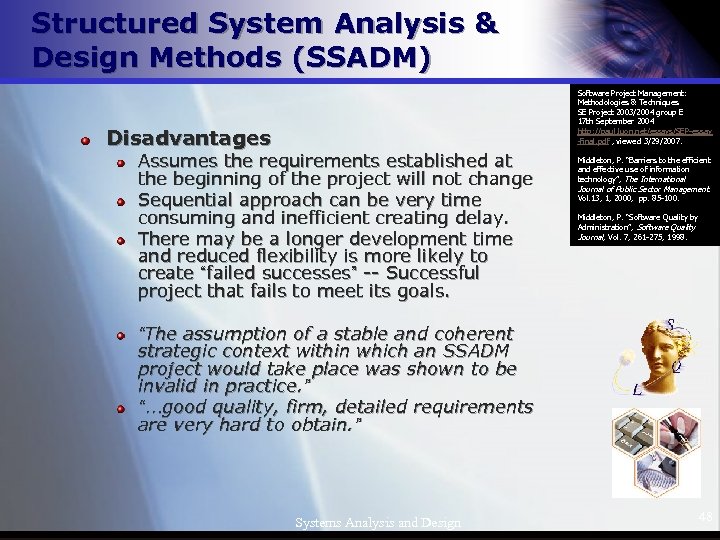
Structured System Analysis & Design Methods (SSADM) Software Project Management: Methodologies & Techniques SE Project 2003/2004 group E 17 th September 2004 http: //paul. luon. net/essays/SEP-essay -final. pdf , viewed 3/29/2007. Disadvantages Assumes the requirements established at the beginning of the project will not change Sequential approach can be very time consuming and inefficient creating delay. There may be a longer development time and reduced flexibility is more likely to create “failed successes” -- Successful project that fails to meet its goals. Middleton, P. “Barriers to the efficient and effective use of information technology”, The International Journal of Public Sector Management. Vol. 13, 1, 2000, pp. 85 -100. Middleton, P. “Software Quality by Administration”, Software Quality Journal , Vol. 7, 261 -275, 1998. “The assumption of a stable and coherent strategic context within which an SSADM project would take place was shown to be invalid in practice. ” “…good quality, firm, detailed requirements are very hard to obtain. ” Systems Analysis and Design 48

Rapid Application Development (RAD) Methods Overview “Iterative” or “incremental” – develop systems in smaller steps with repeated iterations utilizing the information and knowledge gained from the first iteration Rapid Application Development Methods (RAD) Systems Analysis and Design 49

Rapid Application Development (RAD) methods Compton TR, Minimizing waste with RAD, Strategic Finance ; Vol. , 83, 12, 2002; pg. 50 -3. What is RAD? “A systems development philosophy that can be effective in controlling waste and inefficiencies that are so common with system development projects. ” “iterative development, … construction of prototypes, and the use of Computer-aided Software Engineering (CASE) Tools. ” The Goal: High quality systems Rapid Development Reduced cost Systems Analysis and Design 50

Rapid Application Development (RAD) methods Developed in the 1980 s to address some of the shortcomings of SSADM and other structured methodologies Very high level of user involvement fosters commitment and ownership; Rapid response to changing requirements; Multi-disciplinary approach combining users, analysts and technical specialists. Incremental development of large projects “a software product is designed and built in a succession of incremental iterations. ” Modularity allows application to many types of software projects Systems Analysis and Design Software Project Management: Methodologies & Techniques SE Project 2003/2004 group E 17 th September 2004 http: //paul. luon. net/essays/SEP-essay -final. pdf. http: //www. comp. glam. ac. uk/pages/s taff/tdhutchings/chapter 4. html, viewed 3/29/2007. 51

Rapid Application Development (RAD) methods Compton TR, Minimizing waste with RAD, Strategic Finance ; Vol. , 83, 12, 2002; pg. 50 -3. RAD: n Define user requirements n Iterations n n n Build a system prototype Develop and test Deploy Systems Analysis and Design 52
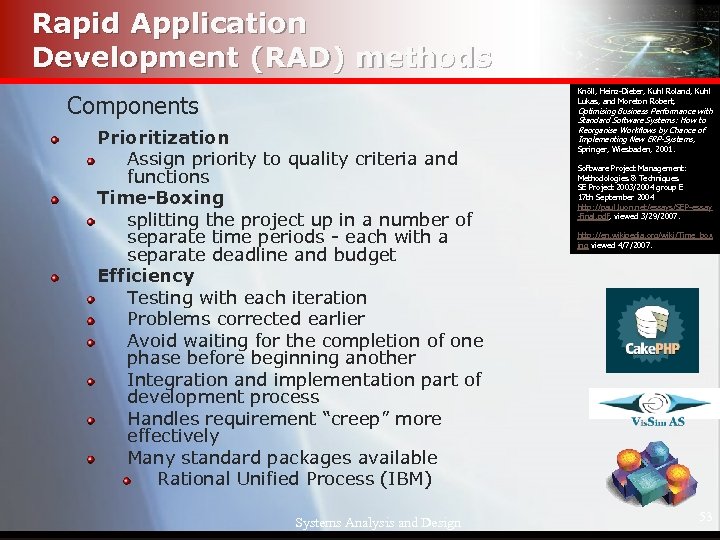
Rapid Application Development (RAD) methods Knöll, Heinz-Dieter, Kuhl Roland, Kuhl Lukas, and Moreton Robert, Components Prioritization Assign priority to quality criteria and functions Time-Boxing splitting the project up in a number of separate time periods - each with a separate deadline and budget Efficiency Testing with each iteration Problems corrected earlier Avoid waiting for the completion of one phase before beginning another Integration and implementation part of development process Handles requirement “creep” more effectively Many standard packages available Rational Unified Process (IBM) Systems Analysis and Design Optimising Business Performance with Standard Software Systems: How to Reorganise Workflows by Chance of Implementing New ERP-Systems, Springer, Wiesbaden, 2001. Software Project Management: Methodologies & Techniques SE Project 2003/2004 group E 17 th September 2004 http: //paul. luon. net/essays/SEP-essay -final. pdf, viewed 3/29/2007. http: //en. wikipedia. org/wiki/Time_box ing viewed 4/7/2007. 53

Rapid Application Development (RAD) methods Components Joint application development (JAD) Beynon-Davies P, Carne C, Mackay H, Tudhope D. , “Rapid application development (RAD): an empirical review, European Journal of Information Systems , Vol. 8, 3, 1999; pp. 211 -222. Small group of users and designers with decision making authority – skilled in design and business Clean rooms JAD remote from the business and free from interruption Incremental prototyping Developers create working model to show users. Developers and users agree on changes and enhancements Repeated until the user is satisfied Highly interactive, low complexity projects Systems Analysis and Design 54
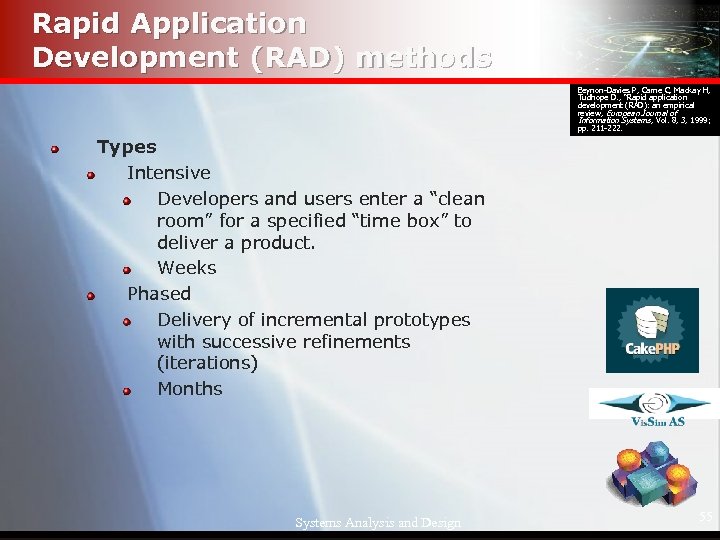
Rapid Application Development (RAD) methods Beynon-Davies P, Carne C, Mackay H, Tudhope D. , “Rapid application development (RAD): an empirical review, European Journal of Information Systems , Vol. 8, 3, 1999; pp. 211 -222. Types Intensive Developers and users enter a “clean room” for a specified “time box” to deliver a product. Weeks Phased Delivery of incremental prototypes with successive refinements (iterations) Months Systems Analysis and Design 55
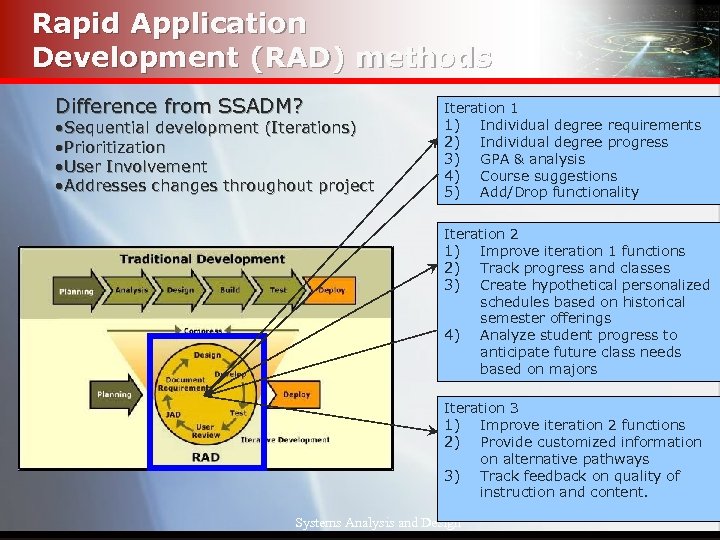
Rapid Application Development (RAD) methods Difference from SSADM? • Sequential development (Iterations) • Prioritization • User Involvement • Addresses changes throughout project Iteration 1 1) Individual degree requirements 2) Individual degree progress 3) GPA & analysis 4) Course suggestions 5) Add/Drop functionality Iteration 2 1) Improve iteration 1 functions 2) Track progress and classes 3) Create hypothetical personalized schedules based on historical semester offerings 4) Analyze student progress to anticipate future class needs based on majors Iteration 3 1) Improve iteration 2 functions 2) Provide customized information on alternative pathways 3) Track feedback on quality of instruction and content. Systems Analysis and Design 56
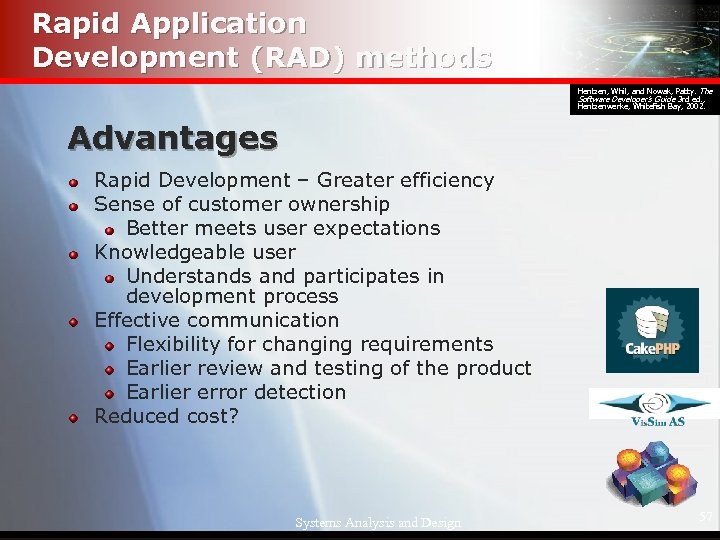
Rapid Application Development (RAD) methods Hentzen, Whil, and Nowak, Patty. The Software Developer’s Guide 3 rd ed. , Hentzenwerke, Whitefish Bay, 2002. Advantages Rapid Development – Greater efficiency Sense of customer ownership Better meets user expectations Knowledgeable user Understands and participates in development process Effective communication Flexibility for changing requirements Earlier review and testing of the product Earlier error detection Reduced cost? Systems Analysis and Design 57
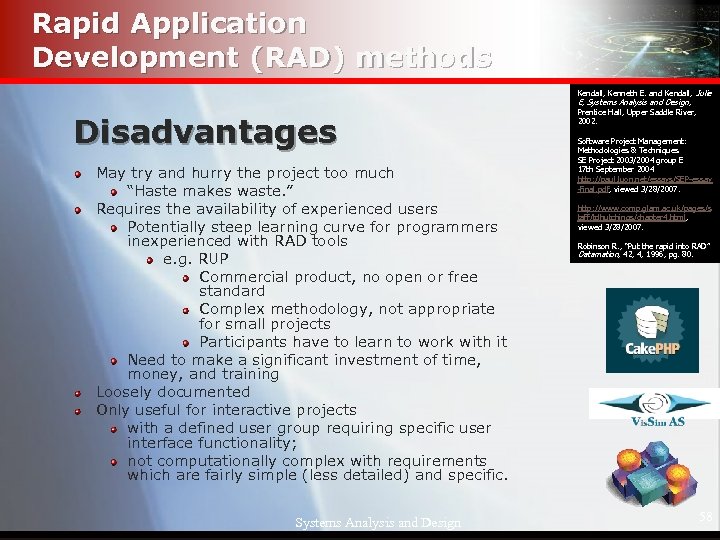
Rapid Application Development (RAD) methods Disadvantages May try and hurry the project too much “Haste makes waste. ” Requires the availability of experienced users Potentially steep learning curve for programmers inexperienced with RAD tools e. g. RUP Commercial product, no open or free standard Complex methodology, not appropriate for small projects Participants have to learn to work with it Need to make a significant investment of time, money, and training Loosely documented Only useful for interactive projects with a defined user group requiring specific user interface functionality; not computationally complex with requirements which are fairly simple (less detailed) and specific. Systems Analysis and Design Kendall, Kenneth E. and Kendall, Julie E, Systems Analysis and Design , Prentice Hall, Upper Saddle River, 2002. Software Project Management: Methodologies & Techniques SE Project 2003/2004 group E 17 th September 2004 http: //paul. luon. net/essays/SEP-essay -final. pdf, viewed 3/28/2007. http: //www. comp. glam. ac. uk/pages/s taff/tdhutchings/chapter 4. html, viewed 3/28/2007. Robinson R. , “Put the rapid into RAD” Datamation, 42, 4, 1996, pg. 80. 58

Summary Successful Systems Analysis and Design: Managerial involvement User involvement Developer involvement Standardized, robust methodology Timely development Mechanisms to adapt to changing requirements Systems Analysis and Design 59
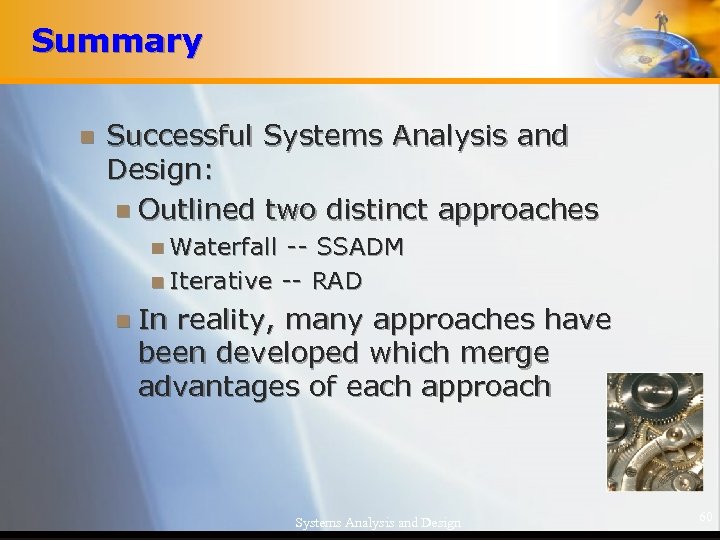
Summary n Successful Systems Analysis and Design: n Outlined two distinct approaches n Waterfall -- SSADM n Iterative -- RAD n In reality, many approaches have been developed which merge advantages of each approach Systems Analysis and Design 60
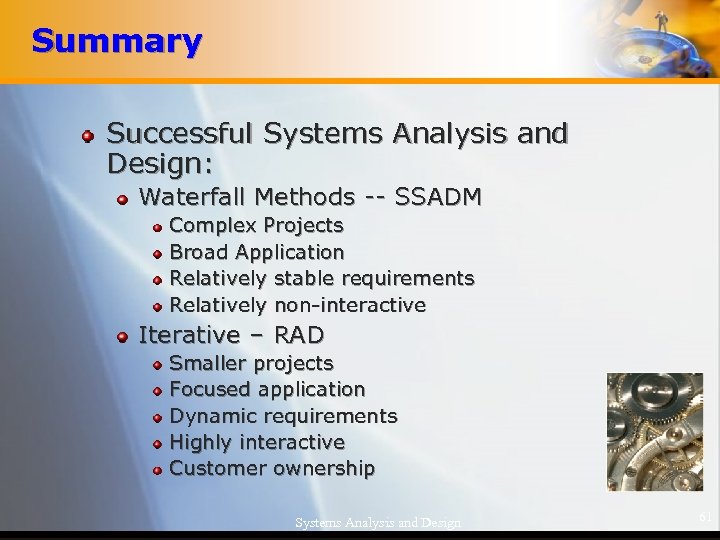
Summary Successful Systems Analysis and Design: Waterfall Methods -- SSADM Complex Projects Broad Application Relatively stable requirements Relatively non-interactive Iterative – RAD Smaller projects Focused application Dynamic requirements Highly interactive Customer ownership Systems Analysis and Design 61
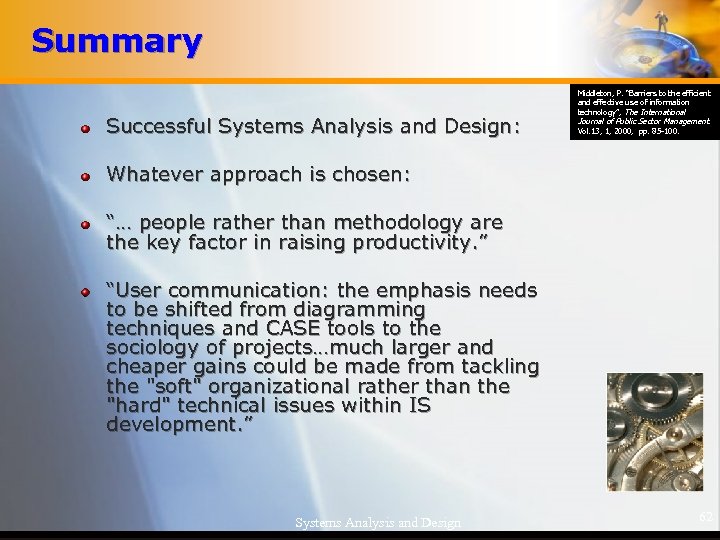
Summary Successful Systems Analysis and Design: Middleton, P. “Barriers to the efficient and effective use of information technology”, The International Journal of Public Sector Management. Vol. 13, 1, 2000, pp. 85 -100. Whatever approach is chosen: “… people rather than methodology are the key factor in raising productivity. ” “User communication: the emphasis needs to be shifted from diagramming techniques and CASE tools to the sociology of projects…much larger and cheaper gains could be made from tackling the "soft" organizational rather than the "hard" technical issues within IS development. ” Systems Analysis and Design 62

QUESTIONS Systems Analysis and Design 63
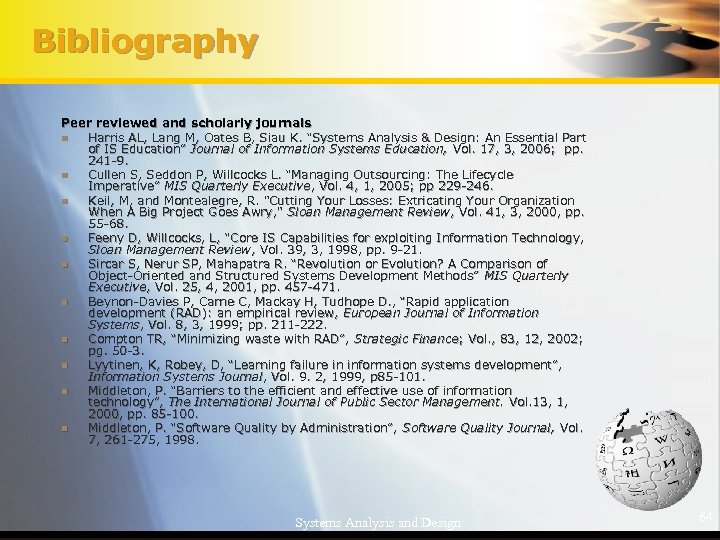
Bibliography Peer reviewed and scholarly journals n Harris AL, Lang M, Oates B, Siau K. “Systems Analysis & Design: An Essential Part of IS Education” Journal of Information Systems Education, Vol. 17, 3, 2006; pp. 241 -9. n Cullen S, Seddon P, Willcocks L. “Managing Outsourcing: The Lifecycle Imperative” MIS Quarterly Executive , Vol. 4, 1, 2005; pp 229 -246. n Keil, M, and Montealegre, R. "Cutting Your Losses: Extricating Your Organization When A Big Project Goes Awry, " Sloan Management Review , Vol. 41, 3, 2000, pp. 55 -68. n Feeny D, Willcocks, L, “Core IS Capabilities for exploiting Information Technology, Sloan Management Review , Vol. 39, 3, 1998, pp. 9 -21. n Sircar S, Nerur SP, Mahapatra R. “Revolution or Evolution? A Comparison of Object-Oriented and Structured Systems Development Methods” MIS Quarterly Executive, Vol. 25, 4, 2001, pp. 457 -471. n Beynon-Davies P, Carne C, Mackay H, Tudhope D. , “Rapid application development (RAD): an empirical review, European Journal of Information Systems, Vol. 8, 3, 1999; pp. 211 -222. n Compton TR, “Minimizing waste with RAD”, Strategic Finance; Vol. , 83, 12, 2002; pg. 50 -3. n Lyytinen, K, Robey, D, “Learning failure in information systems development”, Information Systems Journal, Vol. 9. 2, 1999, p 85 -101. n Middleton, P. “Barriers to the efficient and effective use of information technology”, The International Journal of Public Sector Management. Vol. 13, 1, 2000, pp. 85 -100. n Middleton, P. “Software Quality by Administration”, Software Quality Journal, Vol. 7, 261 -275, 1998. Systems Analysis and Design 64
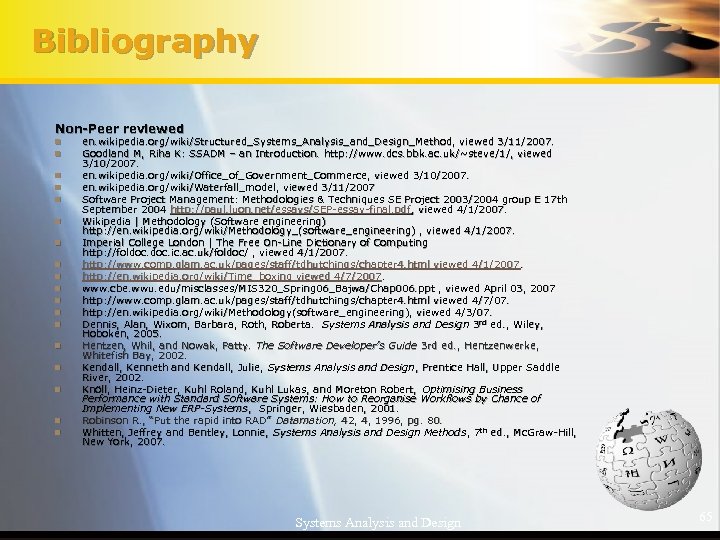
Bibliography Non-Peer reviewed n n n n n en. wikipedia. org/wiki/Structured_Systems_Analysis_and_Design_Method, viewed 3/11/2007. Goodland M, Riha K: SSADM – an Introduction. http: //www. dcs. bbk. ac. uk/~steve/1/, viewed 3/10/2007. en. wikipedia. org/wiki/Office_of_Government_Commerce, viewed 3/10/2007. en. wikipedia. org/wiki/Waterfall_model, viewed 3/11/2007 Software Project Management: Methodologies & Techniques SE Project 2003/2004 group E 17 th September 2004 http: //paul. luon. net/essays/SEP-essay-final. pdf , viewed 4/1/2007. Wikipedia | Methodology (Software engineering) http: //en. wikipedia. org/wiki/Methodology_(software_engineering) , viewed 4/1/2007. Imperial College London | The Free On-Line Dictionary of Computing http: //foldoc. ic. ac. uk/foldoc/ , viewed 4/1/2007. http: //www. comp. glam. ac. uk/pages/staff/tdhutchings/chapter 4. html viewed 4/1/2007. http: //en. wikipedia. org/wiki/Time_boxing viewed 4/7/2007. www. cbe. wwu. edu/misclasses/MIS 320_Spring 06_Bajwa/Chap 006. ppt , viewed April 03, 2007 http: //www. comp. glam. ac. uk/pages/staff/tdhutchings/chapter 4. html viewed 4/7/07. http: //en. wikipedia. org/wiki/Methodology(software_engineering), viewed 4/3/07. Dennis, Alan, Wixom, Barbara, Roth, Roberta. Systems Analysis and Design 3 rd ed. , Wiley, Hoboken, 2005. Hentzen, Whil, and Nowak, Patty. The Software Developer’s Guide 3 rd ed. , Hentzenwerke, Whitefish Bay, 2002. Kendall, Kenneth and Kendall, Julie, Systems Analysis and Design , Prentice Hall, Upper Saddle River, 2002. Knöll, Heinz-Dieter, Kuhl Roland, Kuhl Lukas, and Moreton Robert, Optimising Business Performance with Standard Software Systems: How to Reorganise Workflows by Chance of Implementing New ERP-Systems , Springer, Wiesbaden, 2001. Robinson R. , “Put the rapid into RAD” Datamation, 42, 4, 1996, pg. 80. Whitten, Jeffrey and Bentley, Lonnie, Systems Analysis and Design Methods , 7 th ed. , Mc. Graw-Hill, New York, 2007. Systems Analysis and Design 65
5cfb7de8c1dee6f19306463861cad945.ppt